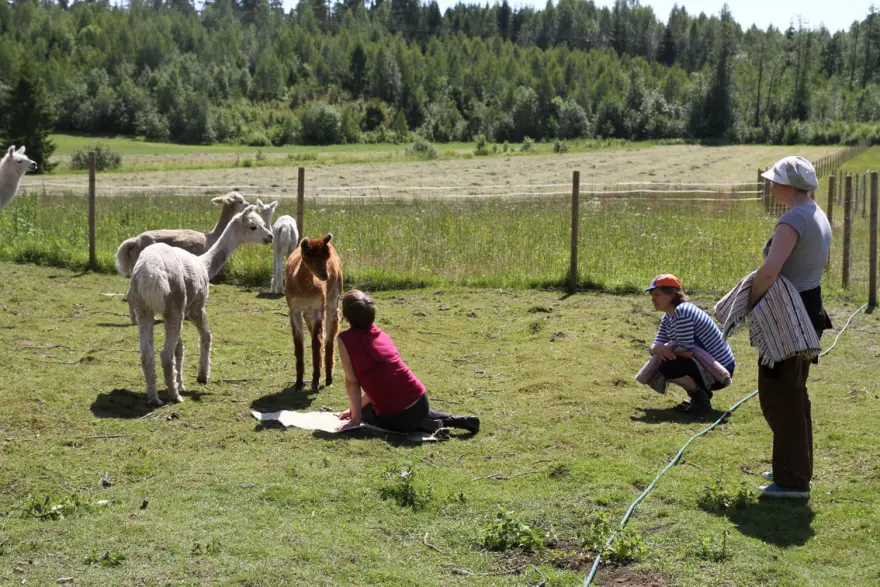Art Creates Dreams, Brings People Together, Provides a Place to Organise – and Can Turn into Action

In the projects curated by contemporary art curator Ki Nurmenniemi, ecological crises have been addressed through themes of dreaming, hope, grief, and agency. The transformative power of art lies in its ability to imagine different worlds.
Ki Nurmenniemi has been curating contemporary art projects focused on ecological issues since the early 2010s. One of her curated projects, Frontiers in Retreat (2013–2018), is a good example of how broad ecological crises can be reflected locally. In this large-scale project, work committed to the environment was carried out with small local communities. The project team observed that art has an exceptional ability to influence people’s imagination: it creates new ideas and stories and prompts action even in the face of seemingly overwhelming challenges. According to Nurmenniemi, this is where the transformative power of the art field lies.
Nurmenniemi is also the co-founder and director of Punos, a new commissioning platform. Punos produces contemporary art addressing ecological crises, emphasising dreaming and envisioning rather than fear. The principle is to give artists and activists support, time, and resources to imagine a better world from their own perspectives. The ideas can be quite radical, but Nurmenniemi believes that wild innovations and artists’ visions can spark societal changes. The era of ecological crises is just one possible world – art and artists are needed to imagine different worlds.
Art Exposes Us to Change
Feedback from the Frontiers in Retreat project was sometimes filled with wonder, Nurmenniemi says, but since then, many ways of thinking that were considered wild and marginal at the time have become mainstream. The responses to several projects curated by Nurmenniemi have echoed a sense of surprise, curiosity and gratitude that art can be used to address and confront phenomena such as the climate crisis.
According to Nurmenniemi, contemporary art works can concretely influence, for example, the environmental behaviour of the audience.
I’ve heard so many stories about how a particular work has completely transformed a person’s worldview.
An artist residency can also be a life-changing experience in many ways, says Nurmenniemi, who is writing a dissertation on residencies. A change in one’s thinking can happen like a bolt from the blue: life no longer looks the same after encountering a particular work or insight. Change can also occur by committing long-term to important values and working towards them.
Nurmenniemi is currently curating a socio-ecologically sustainable exhibition programme at the Lahti Museum of Visual Arts Malva, which is creating materials for a new kind of relationship with nature. She emphasises the importance of influencing through visual art content: it sets the imagination in motion and makes the brain tick in a new way.
And I have personal experience of this. I live very differently now than I did ten or fifteen years ago before I was exposed to these artists’ eco-visions, Nurmenniemi laughs.
New Growth Can Sprout from Crises
According to Nurmenniemi, the attitude towards sustainability work in the visual arts sector has changed significantly over the past 15 years. Organisational sustainability work has expanded from calculating climate emissions to more comprehensive sustainability thinking and more diverse metrics.
I’ve seen the development from ignorance and indifference to growing interest, the first tools, and recognising one’s own transformative power.
Nurmenniemi has worked in both the art and science fields, concretising broad, often abstract crises. She believes that collaboration between art and science offers many opportunities. At its best, it is about deep dialogue, not just illustrating scientific research results, Nurmenniemi notes. According to her, artists know how to ask questions that may not have been considered in the scientific field.
Recent developments that drastically affect global climate work and research worry Nurmenniemi. She believes that visual art could provide tools and forums for collective mourning and discussion, but also for organising. Not all art may remain relevant in an era of climate crisis, but art that creates dreams and brings people together motivates us to keep going, even when times are hard and faith is tested.
It also helps to understand that you are not alone, but there are many people who are interested in the same things, Nurmenniemi reflects.
Working on projects addressing ecological crises has led Nurmenniemi to reassess her own values and practices. Personal awakenings to the sustainability crisis can also lead to organisational changes. The long art processes of the Punos project helped Nurmenniemi understand that there is always hope: new growth can sprout from the midst of catastrophes and crises.
Arundhati Roy has said that on a quiet day, you can hear the new world breathing, that the new world is already sighing there. The burning question is, through what kind of controlled burn or scorching will it happen?vataide voisi tarjota työvälineitä ja foorumeita yhdessä suremiseen ja keskusteluun mutta myös organisoitumiseen. Kaikki taide ei välttämättä pysy relevanttina ilmastokriisin aikakaudella, mutta unelmia luova ja yhteen tuova taide motivoi jatkamaan, vaikka välillä olisi vaikeaa ja usko koetuksella.
“Se auttaa myös ymmärtämään, ettei ole yksin, vaan on paljon ihmisiä, joita kiinnostavat samat asiat “, Nurmenniemi pohtii.